

 |
Laos 2002 |  |
|
Laos Tales Laos is the most bombed country (per head) in the history of warfare. It is one of the 10 poorest countries in the world and has the lowest life expectancy in Asia. You would have thought it had suffered enough without having to endure a visit from the O'Brien brothers. We set off from Singapore via an overnight stop over in Bangkok. We decided to stay one night in the hotel airport rather than sleep down in Bkk's luxurious airport lounges. Our few hours stay in Bangkok was happily eventless bar meeting a couple of Yanks on the way from Hotel who were dead impressed that we were off to somewhere like Laos. Next time we will go to some beach resort in Thailand and tell everyone we are off to somewhere cool sounding. Then I shall just come back afterwards and invent a load of stories and we get the kudos without the discomfort. Vientiane is not like other capital cities. Only place similar I have been is Phnom Penh but that was a bustling metropolis compared to the sleepy Laotian capital by the Mekong. The photos in the album should give some flavour to this place. Right in the heart of town there are plenty of abandoned buildings. There is a hint of old colonial decay about the city; one can sit in the main square eating one's escargots and sipping claret under the shadow of the abandoned four story French cultural centre, the tallest building in the square. In fact considering how light the French presence was in Laos, the French famously found Laos yielded precious little revenue and was mostly useful as a buffer between British Burma and Vietnam, there was a lot of Frenchie stuff on view. Plenty of rusty old signs in French that must have been left over from 1975 at the earliest, even French post boxes. Plenty of very worthy centres and institutions around for les estudes des femmes indochine and other such causes. Not many businesses but plenty of worthy sounding institutions dedicated to enlightening the masses. There is not much to do in Vientiane; which is a shame as it used to be a seedy capital of sin in its pre-revolution days. So we left after 24 hours on a flight to Luang Prabang. We flew internal Lao Aviation, which is flying the old fashioned way as they don't have radar. But I only like airports where one walks across the tarmac and Luang Prabang did not disappoint. Luang Prabang is a nice town; actually it is almost a magical town. The French writer Marthe Bassene wrote in 1909 "Oh what a delightful paradise of idleness this country protects, by the fierce barrier of the stream against progress and ambition for which it has no need! Will Luang Prabang be, in our century of exact sciences, of quick profits, of victory by money, the refuge of the last dreamers, the last lovers, the last troubadours?' Happily Luang Prabang has hardly changed in the last 100 years. Though undoubtedly modernity will ruin it soon it remains an idyllic haven and refuge for anyone who wants to leave the rat race far behind. One does not do much in Luang Prabang, in fact doing a lot would be a rather poor show and very out of keeping with the surroundings. Nestling between the Mekong and the Nam Ou rivers it was the ancient royal capital of Lan Xang Hom Khao (land of a million elephants and white parasol) the medieval Lao Kingdom. It remained the royal centre right up till 1975 when the king was exiled to a cave where he died. In fact one of highlights is walking round the royal palace which has been preserved exactly as it was the day the king left, complete with plates set on the table and records next to the gramophone (which was a gift from the US government). As well as the obligatory temple viewing we watched the local version of the Ramayana ballet in the palace grounds, some of the singers and musicians had played for the king himself when in residence and the oldest was in his seventies. The ballet was followed by a performance by a 'minority' as our host called them, a group from one of the many hill tribes which wore red bandannas (a lot of the tribes wear specific coloured clothing). The tribal dance/show culminated in three of the performers lifting up several gallon jugs of water using their teeth (see photo to believe). I could barely lift the jug an inch off the table no matter swing it about by my molars. From our base in Luang Prabang we took a trip by tuk tuk to the Tat Kuang Si waterfall. There are photos of this idyllic waterfall attached below and it was a lovely place for a dip. Whilst Will and I were swimming we were amazed to see about twenty Dutch girls arrive, change into their bikinis and jump into the waterfall. The waterfall took on the air of some Greek myth as these young ladies frolicked in the frothy waters. Refreshed by our dip we took the tuk tuk back, on the way the driver passed a monk walking home with a 9-foot bamboo pole. Our driver invited the monk to take a lift with us and so William and I moved along to make space. Except the monk, who looked well into his 70s, didn't actually get in the truck but rather stood on the tail gate placing the poll on top of the tuk tuk's roof and held on with his other hand. We drove off with the super-annuated monk hanging on, his monastic robes billowing in the wind. The high point of the holiday was definitely the trek up to the hilltribe village. Now trekking and visiting hilltribes is big business just up the river in Thailand. I often wondered how it could be special anymore as these villagers must be seeing sweaty farangs on a daily basis as one trek and then another comes through. To be fair though people I have met who have done it in Chang Rai highly recommend it. Finding a trekking tour was not so easy in Laos, the authorities are not that keen on it and it took a bit of asking around before we found somewhere. The trek that was agreed consisted of a three hour trip up the Mekong River, a five to six hour uphill trek into the hills and then a night in the hill village with the Hmong tribes people. Then a return home with a stop off at the Pak Ou Buddhist caves, (a temple carved out of the rock by the Mekong). The cruise up the Mekong was wonderfully relaxing and the riverside scenery was breathtaking. The 5 and a half-hour uphill trek in the afternoon sun was extremely painful. Made worse for me by the fact that that day I started getting a real dose of traveller tummy, which became more and more debilitating as the day wore on. The piece de resistance was when my right sandal fell apart after three hours and I had to complete the trek with the sandal hanging on to my foot by the one remaining intact strap. The children in the village had a good laugh at me about that one. I became quite good at balancing on the useless sandal and only fell into one ditch on the way up. William's only problem seemed to be his irresistibility to the leeches, which attached themselves to him whenever they could. The elation I felt when we finally reached the village cannot be described but it was definitely worth the effort. It was hard to find any traces of modernity in the village. The only evidence of the 20th century I saw were the villager's clothing, the flintlock rifles (and are they 20th or 19th?) and cigarettes. Life cannot have changed much for these villagers in three hundred years, though they have only been in Laos for one hundred or so having migrated from Burma, and ultimately Tibet. The kids all came to stare at the visitors, when you are a six-hour uphill trek from the river I guess you don't get too many visitors. The guide actually told us we were the second group he had taken up this year; so the village children aren't bored of western tourists quite yet. In fact they loved it when I chased them round the village though I was concerned as the children all carried other children on their backs and I was convinced they would topple over. The Hmong know farangs well thanks to the wartime experience. When I was in the village one little girl was carrying a US army shell casing in her hand, war detritus is everywhere in Laos. The CIA first started operating in Laos in the early 60s and encouraged the Hmong to fight the Pathet Lao and Vietminh forces at large in the country. The Hmong army was led by general Vang Pao who now lives with a Hmong community in California. One area of Laos is still a closed area for tourists where the Lao army is fighting insurgents that are led by a renegade Lao army general. On the way up to the village we passed by an opium field cultivated by the Hmong. It is interesting that opium growing was fostered by the CIA in the 60s who used the profits from opium runs aboard US aircraft to fund their covert operations in Indochina. Holding the thirty-year-old shell casing in my hand it was hard to imagine the village full of CIA agents as it must have been in the 60s. After chasing around the children we retired to our bamboo hut where the three of us shared a bed, Will, the guide and me (well it was a raised bamboo surface not really a bed). I crashed out early whilst Will gazed at the stars, nice clear skies up at that level. The next morning we rose to the sound of a dozen cockerels and we emerged to see the Hmong start their work at dawn in the morning mists. Some of the tools they used were fascinating; the women grind the corn using a large pounding hammer, which they operate by standing on and rocking back and forth, thereby moving the hammer up and down and crushing the corn. One interesting personal experience for me was slipping in the woods to answer the morning call of nature, whilst there I was disturbed by a cow and then a wild pig; the two animals seemed very curious as to what was going on. A wave to all the villagers who gathered to say bye and we were off down the hill and back to the relative modernity and comfort of Luang Prabang. By this time I was decidedly under the weather and we took it very easy for the next couple of days. We met one Hungarian woman in Luang Prabang who ran a guesthouse and over a leisurely lazy lunch we discussed the pros and cons of life in Laos. We flew back to Vientiane for one more night and stayed in what was the hotel back in the high communist era. The one favoured by politburos around the world. The air of decaying communist décor has a special kind of charm, one typical of the city as a whole. We watched Leeds beat Man U in our last night in Vientiane (you have to go far to escape English football these days) to cap off a very happy holiday. Then there was just time for Will to have an argument with the Lao immigration officials and with me and we were off. Laos is worth a trip. Check out the pickies. |
|
|
|
|
| Another image from the Wat in Vientiane |
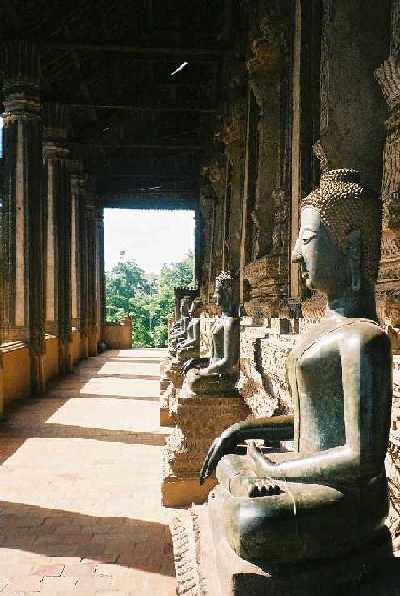 |
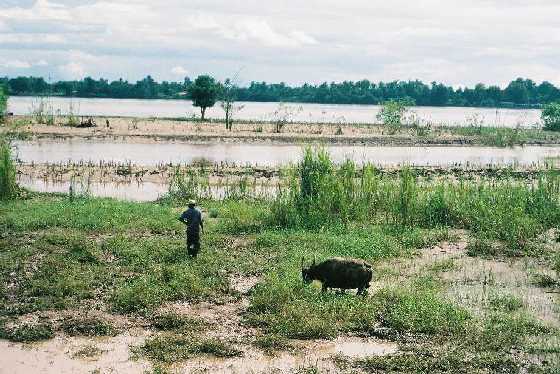 |
Downtown Vientiane in the rush hour, Vibrant! |
| Presidential Palace |
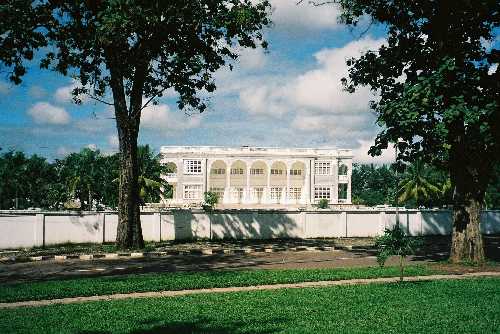 |
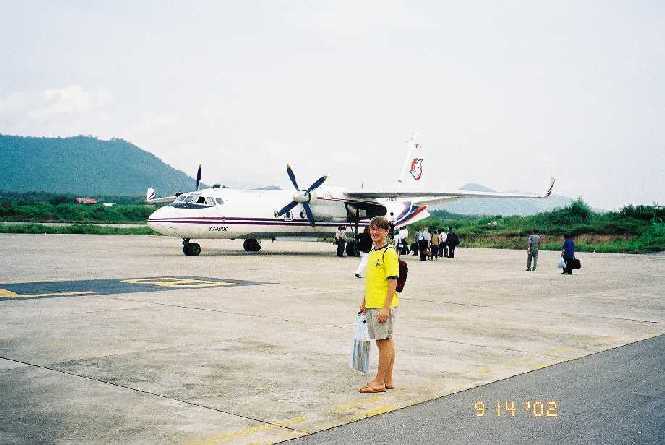 |
Lao Aviation, The only way to fly. |
| Luang Prabang Wat |
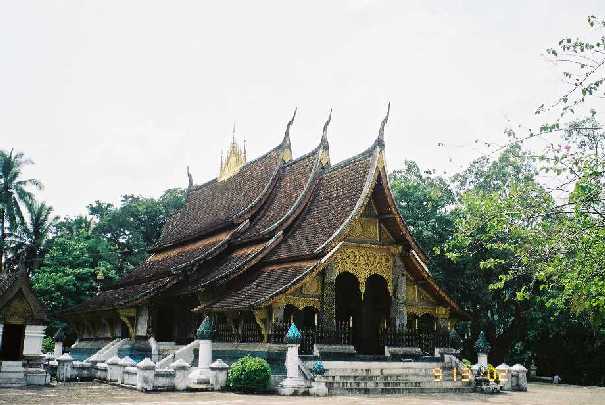 |
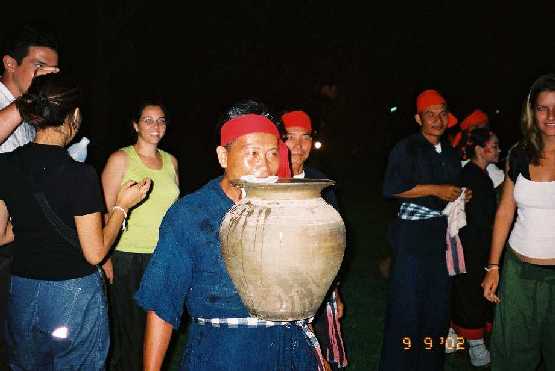 |
Picking up jugs of water with ones hampsteads |
| The brothers Grim |
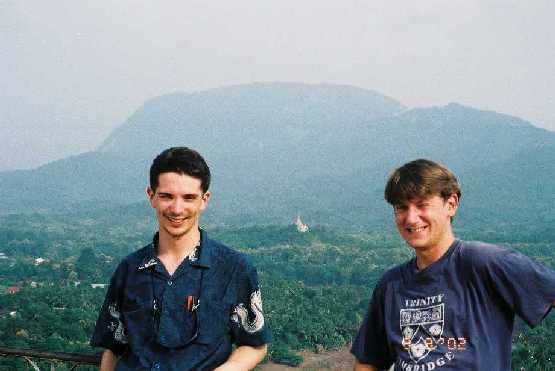 |
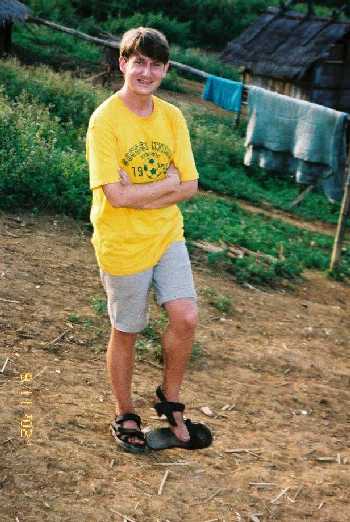 |
The offending footwear |
| The Village in the gloaming |
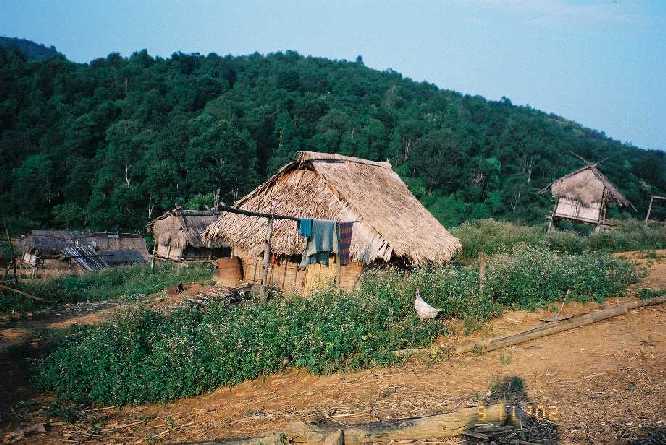 |
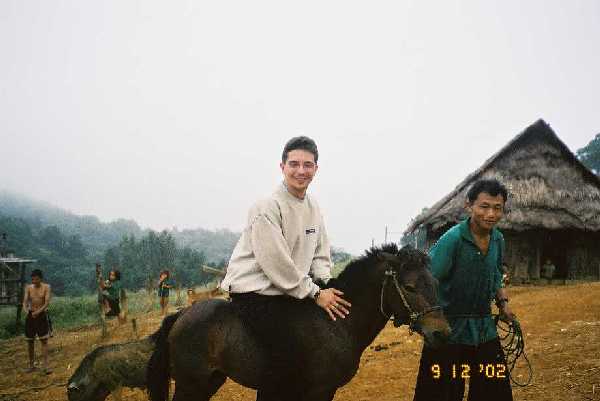 |
Billy the Kid |
| Chasing the kids round the village The little children carry round even tinnier children on their backs. When they run around one is sure that little fella will go flying at some inopportune juncture; most disturbing. Happily they appear to be glued on. |
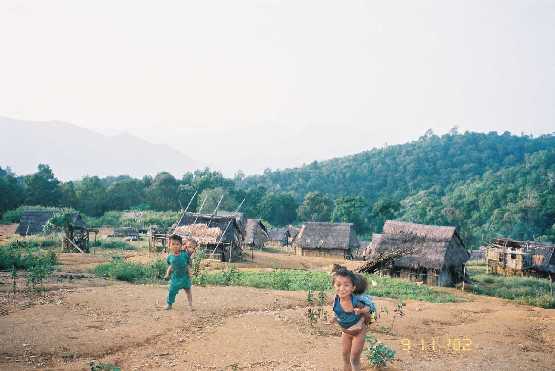 |
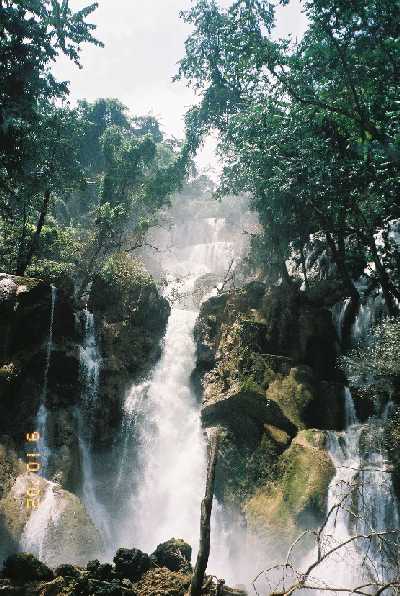 |
Waterfall sans Dutch nymphs alas |
| The Mighty Mekong |
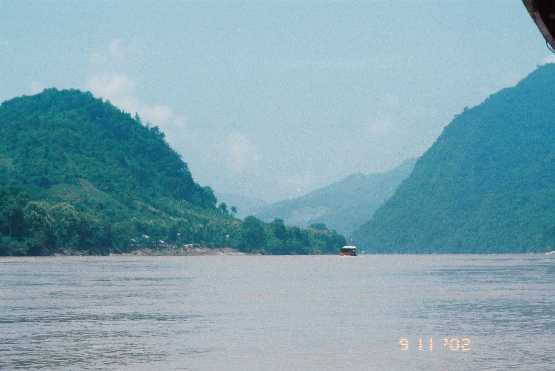 |